Filipino music videos have undergone significant transformations from the 1980s to the present. In the 1980s, Manila Sound's raw, performance-focused aesthetics dominated the scene. This era was characterized by simple, live-performance-based music videos that highlighted the artists' skills.
The 1990s saw a surge in OPM's popularity thanks to MTV's influence****, which increased the visibility of Filipino music globally. This led to more music videos being produced, with a focus on showcasing the artists' personalities and styles.
The 2000s revolutionized music video production and distribution with the advent of digital technology****. This allowed for more creative freedom, lower production costs, and easier distribution. As a result, music videos became more experimental and diverse in terms of style and theme.
In the 2010s, a cultural renaissance emerged, with music videos proudly showcasing Filipino identity****. This was evident in the themes, visuals, and storytelling, which often incorporated elements of Filipino culture, history, and values.
Today, the interplay between technology, culture, and global trends continues to shape the industry's trajectory. The evolution of Filipino music videos is an ongoing narrative, with new trends, styles, and themes emerging continuously.
1980s: Manila Sound's Rise
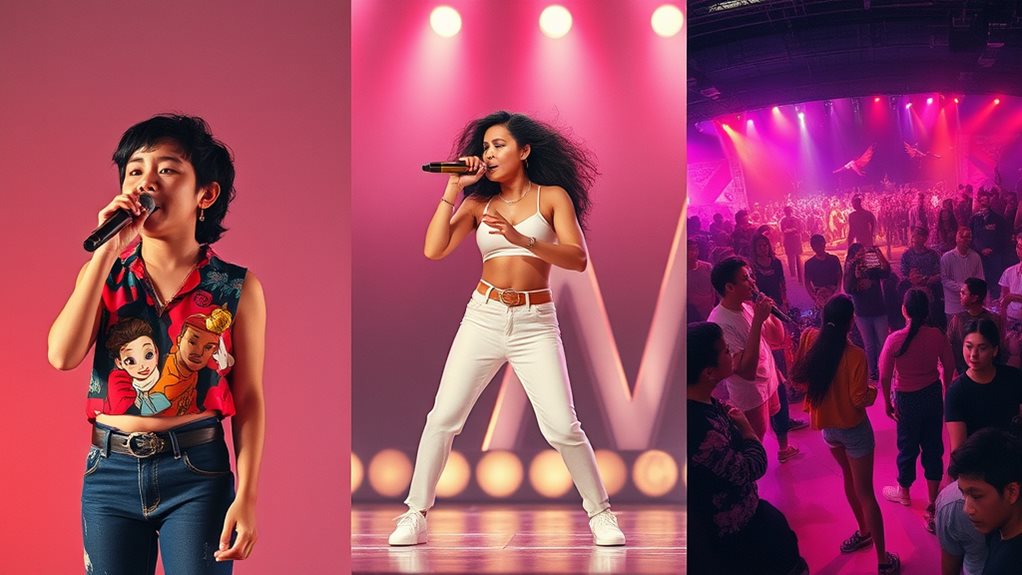
The Manila Sound was a cultural phenomenon that emerged in the 1970s and 80s, blending funk, disco, and traditional Filipino music. This unique sound resonated deeply with the generation, tapping into romantic themes that defined young Filipinos' aspirations and anxieties. For example, VST & Company's energetic beats, APO Hiking Society's harmonies, and Hotdog's rock-disco fusion contributed to a vibrant tapestry of sound.
These artists adapted and reinterpreted international trends, infusing them with a distinctly Filipino flavor. You'll notice nostalgic influences in their music, reflecting the socio-political context they inhabited while navigating themes of love, heartbreak, and everyday life.
The Manila Sound was a cultural expression, a collective voice that reflected the generation's experiences and emotions.
The genre's impact on OPM (Original Pilipino Music) is undeniable; it launched careers, fostered national pride, and provided a foundation for future musical generations. Today, you can still find Manila Sound on playlists, with its romantic themes remaining deeply resonant across generations.
Its success was a result of a meticulously crafted convergence of talent, timing, and a uniquely Filipino sensibility.
Simple Music Video Aesthetics
Simple Sets and Limited Resources****
In the 1980s, Filipino music videos prioritized performance over elaborate narratives due to limited resources. Basic sets and simple props were the norm, and filming was often confined to a single location. Camera work and editing reflected these budget constraints, resulting in a straightforward approach to visual storytelling.
Influence of Western Music Videos****
The aesthetic evolution of Filipino music videos was heavily influenced by Western music videos, mirroring styles popularized by MTV. However, they maintained a distinctly Filipino flavor. Early video technology, mainly VHS, dictated the visual quality.
Raw and Unpolished Aesthetic
OPM artists like Freddie Aguilar and Asin showcased their live performances, reflecting their folk and rock influences. Their music videos often addressed social and political issues**. Technological limitations meant limited access to special effects**, resulting in a raw, unpolished aesthetic.
Distribution and Emphasis
Distribution relied on local television and VHS tapes, reaching a limited audience compared to today. The emphasis wasn't on high production values but on capturing the essence of the music and its message. This period represents a crucial stage in the aesthetic evolution, establishing a foundation for later developments in Filipino music video production.
Creative Ingenuity
The simplicity of these early music videos shouldn't be mistaken for lack of artistry. It reflected the creative ingenuity in overcoming technological and financial barriers. The focus remained firmly fixed on conveying the emotion and message of the song, a simple approach that laid the groundwork for more sophisticated forms of visual storytelling in the future.
1990s: Pinoy Rock Dominates
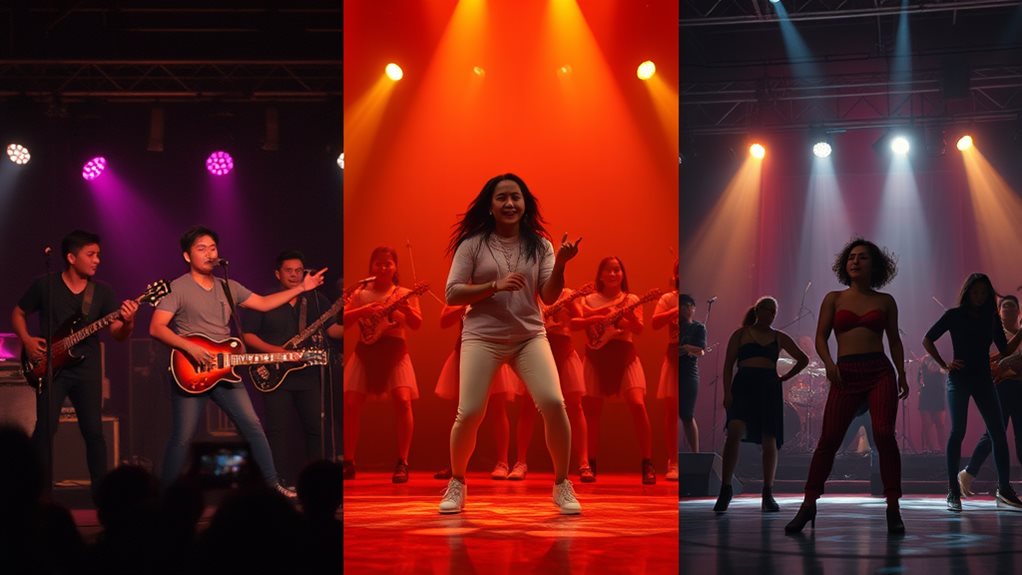
The 1980s Pinoy Rock Era Was Marked by Diversity and Fusion
In the 1980s, Pinoy rock emerged as a vibrant counter-culture that combined limited resources with Western influences. This led to a Punk evolution, inspired by late-'70s acts like the Ramones and the Clash, yet retaining strong Filipino influences.
For example, bands like Identity Crisis featured synth-heavy sounds, while groups like Dead Ends had a grittier tone, showcasing the era's diverse sounds.
Music Collaborations Thrived Despite Limited Radio Significance
Music collaborations flourished within this burgeoning scene, nurtured by grassroots movements and limited radio significance.
DZRJ-AM and WXB 102**** championed original Filipino rock, providing crucial exposure despite the constraints. Local venues became breeding grounds for iconic performances, shaping the Pinoy rock identity.
Cultural Fusion Defined the Pinoy Rock Sound
The cultural fusion evident in bands like Ethnic Faces, which blended rock with jazz, became a hallmark of the era.
The Dawn's "Enveloped Ideas" and Urban Bandits' "No Future Sa Pader" became anthems, while albums like _10 Of Another Kind_ highlighted the best of the alternative scene. Independent labels like Twisted Red Cross provided a platform for many emerging acts.
Grassroots Movements Left a Lasting Legacy
Although media support remained limited, the impact of these bands and their music was undeniable – a testament to their talent and the power of grassroots movements.
This period laid the foundation for future generations, proving the lasting legacy of 1980s Pinoy rock.
The Emergence of MTV
MTV's arrival in the Philippines in 1992 marked a significant moment for the local music scene. This was made possible through a partnership with the STAR group, facilitated by Viacom, which brought global music television to Filipino screens.
Initially broadcasting from The Fort in Taguig and later Ortigas, MTV's programming blended international hits with local content, laying the groundwork for music localization.
The creation of MTV Philippines in 2001 was a crucial shift towards prioritizing local culture and music. As a subdivision of MTV Asia, it focused on showcasing Filipino artists, responding to a strong demand for local music.
This strategy involved collaborations with local companies, boosting the profile of OPM (Original Pilipino Music) and significantly impacting the domestic music industry. Surveys showed a strong preference for local music, mirroring trends in other Asian markets.
MTV's influence was interrupted by a four-year hiatus, but it relaunched in 2014 as MTV Pinoy, partnering with Viva Entertainment.
The channel expanded from a limited broadcast schedule to a full 24-hour channel****, featuring more locally produced shows like "MTV Halo-Halo." This period represented a renewed commitment to music localization for MTV Philippines.
The channel's closure in 2017 marked the end of an era, possibly due to shifting partnerships and competition.
However, its legacy in promoting OPM remains, with the transfer of OPM-related programs to Viva TV indicating a continued, albeit altered, trajectory for Filipino music on television.
2000s: Digital Music's Dawn
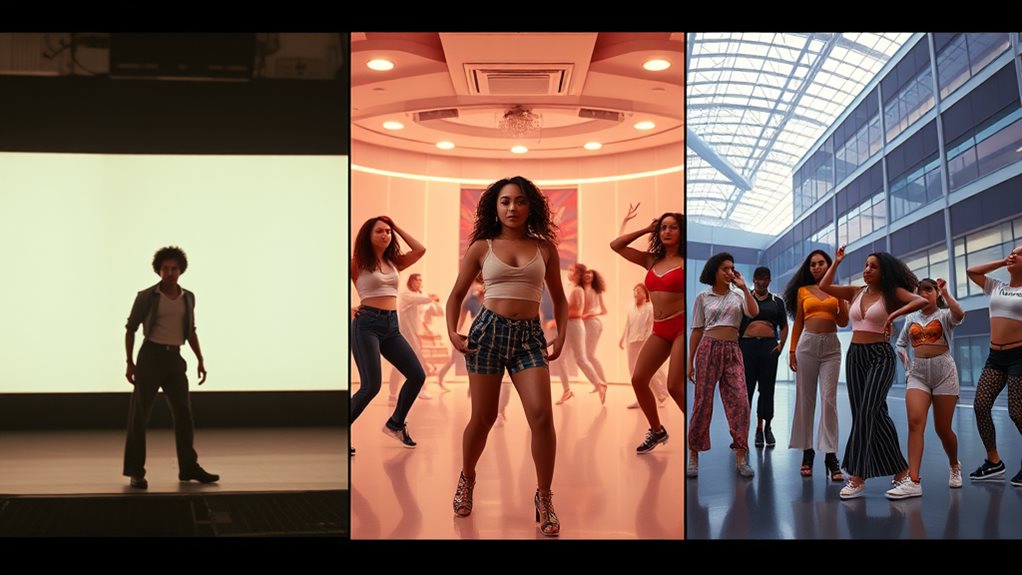
The 2000s marked a significant shift in the Filipino music landscape**** as digital technologies revolutionized music production, distribution, and consumption.
YouTube became a dominant platform, hosting vast collections of OPM music videos. This was followed by the emergence of streaming services like Spotify and Apple Music, which offered global reach previously unimaginable.
Social media integration enabled seamless audience engagement and direct artist-fan interaction. This led to user-generated content, further enriching the digital ecosystem.
Digital monetization models, including ads and streaming royalties, opened new revenue streams for artists. High-definition video became the standard, enhancing visual appeal.
Advanced editing software and online music production tools democratized creation, making sophisticated videos and music accessible to a wider range of creators.
Smartphone improvements further simplified the process, significantly lowering the barrier to entry.
On-demand music and playlist culture impacted how people discovered and consumed Filipino music, expanding global reach and allowing artists to gain international recognition.
However, the ease of digital sharing also presented challenges related to piracy and copyright.
Despite these challenges, the 2000s laid the foundation for the increasingly dynamic and interconnected Filipino music scene we know today.
Rise of Independent Artists
The rise of independent artists transformed the Filipino music industry.
In the 2000s, digital music emerged, making it easier for artists to self-promote and bypass traditional gatekeepers. Online platforms democratized music distribution, allowing independent musicians to thrive without record labels. This led to a surge in artists blending traditional Filipino sounds with international influences, creating unique soundscapes. For example, artists like Urbandub and Bamboo Mañalac combined alternative rock with OPM (Original Pilipino Music) to create a distinct sound.
Collaborations became commonplace, fostering a sense of community and innovation. Artists from different backgrounds united for projects, such as the collaboration between rapper Gloc-9 and singer-songwriter Vinci Montaner on the hit song "Upuan." This spirit of collaboration encouraged creativity and experimentation.
The internet became a breeding ground for creativity, not just a distribution channel. Artists used YouTube and other platforms to build direct relationships with their fanbase, fostering loyalty and organic growth. For instance, singer-songwriter Moira Dela Torre used social media to connect with her audience, eventually topping music charts and selling out concerts.
This shift challenged the established norms of the music industry, compelling major labels to adapt or become irrelevant. The resulting independent music scene is vibrant, diverse, and constantly evolving, pushing boundaries and experimenting with sound.
Filipino artists have leveraged technology to redefine success in the music industry, measuring it by genuine connection with their audiences rather than just chart positions.
2010s: P-Pop's Resurgence
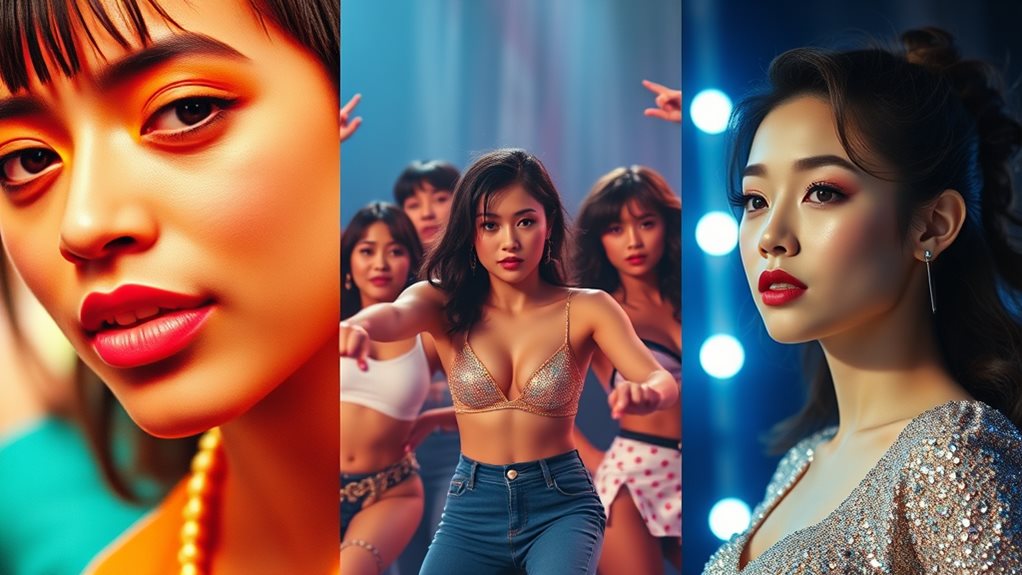
P-Pop's Resurgence in the 2010s
The 2010s saw a resurgence of P-Pop, driven by the growing influence of K-Pop and J-Pop. This resurgence is characterized by the adoption of idol group formats, rigorous training under companies like those in Korea, and a stylistic shift incorporating Asian-style ballads and EDM.
The Emergence of New Groups
The debut of groups like SB19 (2016) and MNL48 (2018) marked a turning point in P-Pop's history. These groups, along with later additions such as BINI and Alamat, showcased polished performances and dynamic dance routines, defining a new era of performance artistry. Their success highlights the impact of P-Pop's strategic use of digital platforms, fostering strong fan engagement and boosting global collaborations.
Key Features of P-Pop's Resurgence
| Feature | Impact |
|---|---|
| Music Diversity | Blending traditional Filipino sounds with contemporary styles |
| Cultural Fusion | Incorporation of Filipino languages and cultural elements |
| Fan Engagement | Strong online presence and active fan communities |
| Digital Platforms | Utilizing YouTube, TikTok, and Spotify for global reach |
Cultural Fusion and Musical Diversity
P-Pop's cultural fusion is evident in lyrics and performances, broadening its appeal. Groups prioritize both musical diversity and the use of Filipino languages, establishing connections with local audiences while fostering global recognition. However, the reliance on existing Asian pop models suggests a need for more unique, emerging trends within P-Pop to create a distinct identity beyond its strong influences.
The Future of P-Pop
The future of P-Pop hinges on balancing its influences with the development of truly original Filipino sounds.
High-Production Music Videos
The pursuit of high production values has consistently shaped the trajectory of Filipino music videos.
The 1980s laid the groundwork for future advancements with polished music videos. Artists like Ric Segreto and Basil Valdez showcased simple yet effective visuals, building on the Manila Sound's foundation.
The 1990s and 2000s saw technological leaps****. Digital effects and sophisticated storytelling became commonplace, with artists like Regine Velasquez and Sarah Geronimo leading the charge in higher-quality productions. This led to increased airtime on local channels and MTV Asia, broadening their reach.
The 2010s harnessed the power of YouTube and social media**. Viral hits** like Sarah Geronimo's "Tala" demonstrated the potential of high-production values—elaborate choreography, detailed sets, and professional editing—to achieve unprecedented audience engagement.
P-pop groups further embraced this visually-driven approach, showcasing their music through high-quality videos.
Contemporary music videos have pushed the boundaries of visual innovation**. 4K resolution**, drone shots, and sophisticated special effects are now standard, maximizing audience engagement.
Social media remains a vital platform, propelling videos to viral success and setting a high bar for the industry.
2015-2019: Cultural Identity
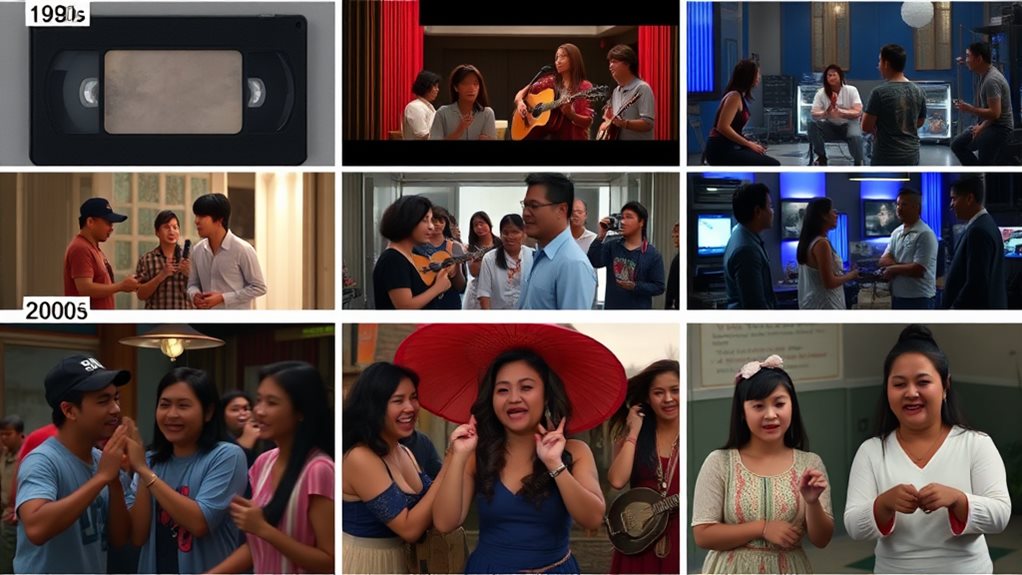
Filipino music videos from 2010 to 2019 reflect the nation's cultural identity, blending traditional and modern elements. This blend showcases the complexities of Filipino cultural expression, with the enduring legacy of Spanish and American influences evident.
Artists incorporate elements of *harana* and *kundiman* into contemporary sounds to preserve cultural identity. Regional variations enrich the tapestry, with unique musical traditions from different localities. For instance, folk music elements are blended with jazz to create a distinctly Filipino sound.
This period sees a surge in patriotic themes, reaffirming national identity. Music videos reflect social realities, tackling issues like the hardships faced by Overseas Filipino Workers.
Artists like Ronnie Liang contribute to a cultural renaissance by translating popular songs into local languages, such as Kapampangan. The 2010s also marked the rise of K-Pop and J-Pop influence, creating a vibrant fusion of Asian styles with Filipino sensibilities.
Idol groups emerged, demonstrating a creative synthesis of Asian pop music with Filipino cultural expression. Nostalgia, Filipino humor, and relatable local scenarios enhance the cultural relevance of these music videos.
Thematic Storytelling in Videos
Thematic Storytelling in Filipino Music Videos****
Filipino music videos have undergone a significant transformation in their thematic storytelling over the years. This evolution is evident in the shift of focus from socio-political commentary to diverse narratives.
The 1980s: Music videos reflected the political unrest and cultural nostalgia of the time. Lyrical analysis reveals a focus on national identity and social justice****, as seen in songs that addressed issues like martial law and social inequality.
The 1990s: The decade saw a diversification of themes, with music videos increasingly used as storytelling tools. Artists balanced exploring contemporary issues with embracing mainstream pop sensibilities. For example, music videos addressed topics like environmental degradation and social awareness.
The 2000s-2010s: Nostalgia became a significant theme, with artists revisiting past eras. Visual symbolism played a crucial role in enriching the narratives, as seen in music videos that incorporated vintage imagery and retro aesthetics.
The production quality also improved, enhancing the storytelling power of music videos.
The 2010s-Present: The resurgence of P-Pop led to highly produced videos, showcasing vibrant dance routines and diverse narratives.
Lyrical analysis reveals how cultural renaissance movements are reflected through music videos, such as the revival of traditional Filipino clothing and the celebration of cultural heritage. The influence of international styles is also evident in both production styles and thematic exploration.
Present and Future Trends
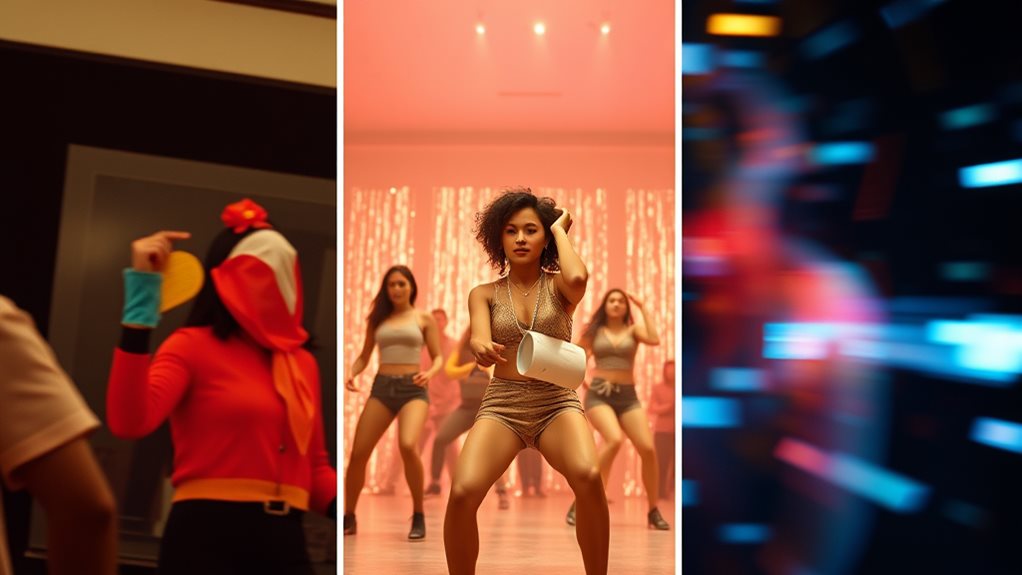
The Philippine music scene is experiencing a dynamic evolution in music video production.
This evolution is characterized by a strong influence from K-pop and J-pop, reflecting their popularity. As a result, Asian-style ballads and EDM are being integrated into music videos, reducing the previous reliance on Western genres. For instance, genre fusion is becoming increasingly prevalent, with artists blending alt-rock with '80s influences or incorporating hip-hop and R&B elements. The rise of P-pop to mainstream success, alongside the emergence of diverse artists, showcases this trend.
Technological advancements have significantly impacted the music industry in the Philippines.
Improved production quality reflects the country's economic growth, with enhanced visual effects and cinematography meeting global standards. Streaming trends are profoundly affecting music distribution and promotion, with platforms like Spotify and YouTube becoming crucial. This increased accessibility allows artists greater control over production and publishing.
The impact of streaming trends on the music industry is undeniable.
Filipino artists are gaining international recognition, with songs appearing on global charts like Billboard PH. Increased collaboration with international artists and producers further cements this global reach. Local awards and charts, coupled with social media's promotional power, amplify the success of Filipino music globally.
The future of the Philippine music industry likely involves:
- Further genre fusion, with artists continuing to experiment with different styles and sounds.
- Sophisticated visuals, driven by advancements in technology and production quality.
- A continued ascent in the global music scene, fueled by evolving streaming trends and increased international recognition.
Questions and Answers
How Did Censorship Affect Early Music Videos?
Censorship stifled artistic expression in early music videos. Strict regulations limited content, forcing creators to employ subtle methods to convey their messages. For instance, music videos were prohibited from displaying explicit violence, sexual content, or profanity. As a result, artists had to find alternative ways to express themselves, often using metaphors or symbolism to convey their intended message.
What Role Did Foreign Directors Play?
Foreign directors played a significant role in facilitating cultural exchange. Through their work, they introduced stylistic influences from their native countries, which had a profound impact on local filmmaking. Initially, their contributions were limited, but they gradually grew, bringing new production values and techniques to the table. As a result, local talent was enriched, and the overall quality of films improved.
Did Budget Constraints Affect Video Quality?
Budget constraints significantly affected video quality. The limited resources resulted in a noticeable impact on the overall production quality, particularly in the visuals and storytelling aspects.
How Did Fan Interactions Shape Video Content?
Fan feedback has directly influenced video content across decades.
Audience engagement has driven stylistic choices in video content. For instance, the popular TV show "Stranger Things" incorporated nostalgic value from the 1980s, heavily influenced by fan feedback on social media platforms. The show's creators took note of fans' love for retro elements, such as vintage clothing and classic sci-fi references, and incorporated them into the show's aesthetic.
Cultural themes have also been shaped by fan interactions. The animated series "Avatar: The Last Airbender" addressed complex issues like war, colonialism, and identity, responding to fans' desire for more mature and diverse storytelling. The show's creators engaged with fans online, taking their feedback into consideration when developing the series' narrative.
Production values have been elevated due to fan engagement. The Marvel Cinematic Universe (MCU) is a prime example of this. Fans' enthusiasm for the franchise led to increased production values, with bigger budgets and more elaborate action sequences. The MCU's success is largely attributed to its ability to listen to fan feedback and incorporate it into the films.
Which Music Video Directors Became Iconic?
Iconic music video directors mastered visual storytelling through innovative techniques and impactful visuals.
One example is Mark Romanek, who directed music videos for artists like Nine Inch Nails and Jay-Z. Another iconic director is Spike Jonze, known for his work with Weezer and Björk. Hype Williams also made a name for himself with his visually striking videos for Kanye West and Beyoncé. These directors have established themselves as masters of visual storytelling in the music industry.